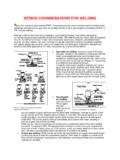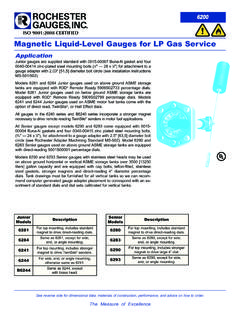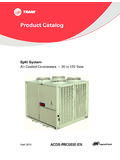Transcription of Cable Selection and Termination In A Environment
1 Authored by: Michael A. Balog, Jr. Associate and Senior Electrical Project Manager For more information, contact: CCG Facilities Integration Incorporated 1500 S. Edgewood Street | Baltimore MD 21227 Phone 410 525 0010 | Fax 410 525 1570 Cable Selection and Termination considerations In A Mission Critical Environment October 6, 2015 This White Paper describes the importance of both the quality of power distribution equipment and the overall integrity of its installation in a mission critical Environment . CCG Technical White Paper Cable Selection and Termination considerations In A Mission Critical Environment 2015 CCG Facilities Integration Incorporated Page 1 of 7 Cable Selection and Termination considerations In A Mission Critical Environment The reliability of mission critical power systems depends upon not only the quality of power distribution equipment but the overall integrity of the installation.
2 Incorrect Selection of wiring types and the manner in which their terminations are made can imbed underlying risks which may not be immediately evident. As there are many varieties of wiring types, each having properties advantageous for particular applications, there are also many types of wiring Termination materials to be considered for system reliability. Incorrect wiring connections frequently become the weakest element in a critical power path. However, to select the proper and most effective conductor Termination hardware and evaluate its strengths and understand its shortcomings, an awareness of the various types of cables available, their construction, and the particular applications to which they are suited. Types of wire Termination devices, frequently referred to as connectors or often lugs , are one of the most important material Selection decisions, especially in mission critical construction.
3 Often, wiring Termination failures are found to be the root cause of costly equipment failures and facility downtime. Occasionally assumed to be acceptable if UL listed, various types of wire connectors are not equivalent. UL Listings are very specific about connector suitability for different classes of building wire. ELECTRICAL CONDUCTOR VARIETIES The terms Cable and wire are frequently interchanged. To be specific, however, wire generally refers to a single conductor strand. Whereas Cable refers to are made from multiple wire strands, either individually insulated and manufactured as a single multi conductor assembly, or constructed as a group of single bare strands of smaller wire bundled and grouped together to form a single conductor. Cable stranding yields a greater flexibility than that of an equivalently sized solid conductor. Bunching smaller wires prior to concentric stranding gives a Cable an additional flexibility than is achieved by concentric construction alone.
4 Cables are classified based on the wire stranding size, number of strands, and the manner in which the wires are twisted together forming a variety of configurations. The most common types are the four types of concentric cables, bunched cables, and rope laid cables. To decrease Cable size, conductors can also be compressed or the stranding compacted. General building wiring conductors larger than American Wire Gauge (AWG) Number 4 are multi stranded cables fabricated using a mixture of wire sizes and stranding which were specifically developed for a particular application and are designated as specific Cable Stranding Classes. Conductor stranding is classified by the manner in which the individual wire strands are sized and arranged for a given Cable conductor function and are designed to satisfy a particular application s needs better than standard building wire, which is a concentric wire construction.
5 Stranded conductors are manufactured in a variety of configurations; the most common being Concentric, Bunched, and Rope as follows: CCG Technical White Paper Cable Selection and Termination considerations In A Mission Critical Environment 2015 CCG Facilities Integration Incorporated Page 2 of 7 A. Concentric Construction stranding is further subdivided into four categories: True Concentric, Equilay, Unidirectional, and Unilay. True Concentric is generally referred to Concentric and is the most commonly used concentric stranding conductor. The remaining three wire lays are for specialty uses and are included for reference only. 1) Concentric or True Concentric is produced using a central wire surrounded by layers of alternately reversed helically laid wires using a geometric pattern.
6 2) Equilay Concentric is produced using a center strand surrounded by additional geometric pattern helically laid wires layers having alternately reversed lay directions of the same layer lengths. 3) Unidirectional Concentric is produced using a center strand surrounded by additional geometric pattern helically laid wires layers having the same lay direction and increasing layer lengths. 4) Unilay or Unidirectional Equilay is produced using a center strand surrounded by additional geometric pattern helically laid wires layers having the same lay direction and same layer lengths. B. Bunched Strand Construction stranding utilizes a random pattern having a varying number of strands twisted while forming. All strands are the same lay length and laid in the same direction. This produces rougher surface having a lower dimensional tolerance than concentric wire lays. The total required cross sectional area together with the individual wire diameter determines required the number of strands.
7 C. Rope Strand Construction incorporates groups of single strands arranged into concentric or bunched bundle configurations. The term bunch stranding is applied to a collection of strands twisted together in the same direction. This arrangement provides increased flexibility due to the greater number of fine wire strands and maintains a firmer assembly than simple concentric or bunched fabrication. D. Compact Stranding: A compact stranded conductor is manufactured by pre forming each strand into a trapezoidal shape before the wires are laid together forming the finished conductor. This produces the minimum possible space between strands thereby reducing the Cable diameter by about 10%. E. Compressed Stranding: Compressed conductors are an intermediate size between standard concentric conductors and compact stranded conductors. The conductor is compressed by putting it through a die which reduces partial the space between strands resulting in an approximate 3% reduction in diameter.
8 CCG Technical White Paper Cable Selection and Termination considerations In A Mission Critical Environment 2015 CCG Facilities Integration Incorporated Page 3 of 7 Cables are organized in the following Cable Classes for reference by application. Major Stranding Classes are defined as: A. Concentric Lay Conductors 1) Class B: Power Cables. 2) Class C: Power cables where more flexible stranding than Class B is desired. 3) Class D: Power cables where extra flexible stranding is desired. B. Rope Lay and Bunch Stranded Conductors 1) Class G: All cables for portable use. 2) Class H: Cables where extreme flexibility is required. ( take up reels) 3) Class I: Apparatus Cable and motor leads. 4) Class K: Cords and cables using No. 30 AWG copper stranding for stationary service use.
9 5) Class M: Cords and cables using No. 34 AWG copper wires for constant service. In building construction, Class B stranding is the most prevalent. Conductors are concentrically laid wire strands which contain air voids between the individual circular strands within the Cable , as opposed to compact stranding. These cables are suitable for conduit, raceway, and Cable tray installation where ordinary flexibility is sufficient for installation. The Cable consists of a concentric stranded conductor core surrounded by one or more layers of helically laid wires. Each layer thereafter has six more wires than the preceding layer. Each layer is then applied in a direction opposite to the preceding layer. For specialized application use such as battery post Termination more flexible fine stranding, such as Class K or Class M, is preferred to minimize wire bending push back to avoid excessive force on the equipment.
10 WIRING Termination Basically the purpose of a Cable connector is to electrically and mechanically join the Cable conductor to the equipment in a manner which provides the following properties: 1) Provide a strong mechanical grip providing substantial Cable pull out resistance thereby ensuring a reliable method of mechanically holding a Cable conductor in place. 2) Provide retention of wire strands within the connector when the Cable is flexed. 3) Provide a low contact resistance between itself and the bus or device to which the conductor is connected. 4) Prevent electrical degradation due to thermal expansion cycling of the connector and wire thereby reducing the clamping forces and increasing the electrical resistance of the connection. CCG Technical White Paper Cable Selection and Termination considerations In A Mission Critical Environment 2015 CCG Facilities Integration Incorporated Page 4 of 7 5) Provide a gas tight electrical contact to prevent oxidation and corrosion of the electrical contact surfaces.







